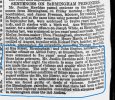-
Welcome to this forum . We are a worldwide group with a common interest in Birmingham and its history. While here, please follow a few simple rules. We ask that you respect other members, thank those who have helped you and please keep your contributions on-topic with the thread.
We do hope you enjoy your visit. BHF Admin Team
You are using an out of date browser. It may not display this or other websites correctly.
You should upgrade or use an alternative browser.
You should upgrade or use an alternative browser.
Destination on release from prison D.P.A.S
- Thread starter Alberta
- Start date
This describes DPAS Alberta
"The DPAS was an umbrella name for a national but disparate organisation and provided a range of services for people leaving prison, provided entirely with re-settling ex-prisoners in mind. Their chief aim was to find employment and temporary lodgings for a discharged prisoner, or, if he or she had what they considered to be a respectable home, to help with travel expenses to their home. Where there were no relatives and the person concerned consented, the aid societies could organise emigration for the discharged prisoner. Most of these aid societies had small amounts of government funding, although some refused all government funding to remain independent (such as the Gloucestershire society and the York Castle society). Many were active in providing voluntary, charitable aftercare for ex-prisoners well into the twentieth century until aftercare was provided on a statutory footing through the probation service as they took over charitable provision from 1907 onwards (Mair & Burke, 2012). Residential aftercare for ex-prisoners was provided on an extremely ad hoc basis and during the late nineteenth century was entirely provided by such faith-based charities. The 1914 Criminal Administration Act gave the courts powers to add a condition of residence to a probation order and paved the way for the establishment of hostels. Hostels (now ‘approved premises’) established under the 1914 Act were primarily for young offenders, although over the century they had been made use of by a more diverse set of offenders, including ex-prisoners released on licence (Wincup, 2007). Now residential care for offenders is almost entirely on a statutory level, but some charitable provision remains. In the late nineteenth century residential aftercare for ex-prisoners on licence was entirely provided by the DPAS or faith institutions and at the local level by the DPAS." (Source: British Journal of Community Justice: Female Prisoners, Aftercare and Release: Residential Provision and Support in Late Nineteenth-Century England)
"The DPAS was an umbrella name for a national but disparate organisation and provided a range of services for people leaving prison, provided entirely with re-settling ex-prisoners in mind. Their chief aim was to find employment and temporary lodgings for a discharged prisoner, or, if he or she had what they considered to be a respectable home, to help with travel expenses to their home. Where there were no relatives and the person concerned consented, the aid societies could organise emigration for the discharged prisoner. Most of these aid societies had small amounts of government funding, although some refused all government funding to remain independent (such as the Gloucestershire society and the York Castle society). Many were active in providing voluntary, charitable aftercare for ex-prisoners well into the twentieth century until aftercare was provided on a statutory footing through the probation service as they took over charitable provision from 1907 onwards (Mair & Burke, 2012). Residential aftercare for ex-prisoners was provided on an extremely ad hoc basis and during the late nineteenth century was entirely provided by such faith-based charities. The 1914 Criminal Administration Act gave the courts powers to add a condition of residence to a probation order and paved the way for the establishment of hostels. Hostels (now ‘approved premises’) established under the 1914 Act were primarily for young offenders, although over the century they had been made use of by a more diverse set of offenders, including ex-prisoners released on licence (Wincup, 2007). Now residential care for offenders is almost entirely on a statutory level, but some charitable provision remains. In the late nineteenth century residential aftercare for ex-prisoners on licence was entirely provided by the DPAS or faith institutions and at the local level by the DPAS." (Source: British Journal of Community Justice: Female Prisoners, Aftercare and Release: Residential Provision and Support in Late Nineteenth-Century England)
Thanks Viv, it looks like it didn't find him much time looking for work or lodging by April 1891.
The prisoner is John Hughes , a nail caster born circa 1852.I found him in prison 1881 but cannot find his 'crime'
In 1891 my husbands great grandmother Fanny Taylor is living with John as his wife , with her 2 children Frank and Joe Taylor both misspelt as Faylor.
The prisoner is John Hughes , a nail caster born circa 1852.I found him in prison 1881 but cannot find his 'crime'
In 1891 my husbands great grandmother Fanny Taylor is living with John as his wife , with her 2 children Frank and Joe Taylor both misspelt as Faylor.
Last edited:
Maybe he was a 'star' prisoner (Source: The Institutional History Society)
"In 1880, Chatham Prison was selected to receive “star class” convicts: men with no previous convictions. They were sent here for public works but kept separate from other classes of prisoners as this was thought to discourage the learning of criminal habits"

Image dated 1861
"In 1880, Chatham Prison was selected to receive “star class” convicts: men with no previous convictions. They were sent here for public works but kept separate from other classes of prisoners as this was thought to discourage the learning of criminal habits"

Image dated 1861
Radiorails
master brummie
Janet Hunt
master brummie
I think I may have found John's crime and looks like his sentence was to make an example of the young men at that time:Thanks Viv, it looks like it didn't find him much time looking for work or lodging by April 1891.
The prisoner is John Hughes , a nail caster born circa 1852.I found him in prison 1881 but cannot find his 'crime'
In 1891 my husbands great grandmother Fanny Taylor is living with John as his wife , with her 2 children Frank and Joe Taylor both misspelt as Faylor.
Attachments
Janet Hunt
master brummie
1856 – Aid Society – Birmingham Discharged Prisoners’ Aid Society founded.

 institutionalhistory.com
institutionalhistory.com
 warwick.ac.uk
warwick.ac.uk

Timelines - The Institutional History Society
Crimes, Prisons and Punishment Important Laws and Acts which affected institutions of the Victorian Period Medicine, Health & Healing a Timeline of 19th Century England
 institutionalhistory.com
institutionalhistory.com
The Victorian City
Canuck DGS
Brummie babby
Am interested in this quote - Where there were no relatives and the person concerned consented, the aid societies could organise emigration for the discharged prisoner. Would such a thing have existed in 1840?This describes DPAS Alberta
"The DPAS was an umbrella name for a national but disparate organisation and provided a range of services for people leaving prison, provided entirely with re-settling ex-prisoners in mind. Their chief aim was to find employment and temporary lodgings for a discharged prisoner, or, if he or she had what they considered to be a respectable home, to help with travel expenses to their home. Where there were no relatives and the person concerned consented, the aid societies could organise emigration for the discharged prisoner. Most of these aid societies had small amounts of government funding, although some refused all government funding to remain independent (such as the Gloucestershire society and the York Castle society). Many were active in providing voluntary, charitable aftercare for ex-prisoners well into the twentieth century until aftercare was provided on a statutory footing through the probation service as they took over charitable provision from 1907 onwards (Mair & Burke, 2012). Residential aftercare for ex-prisoners was provided on an extremely ad hoc basis and during the late nineteenth century was entirely provided by such faith-based charities. The 1914 Criminal Administration Act gave the courts powers to add a condition of residence to a probation order and paved the way for the establishment of hostels. Hostels (now ‘approved premises’) established under the 1914 Act were primarily for young offenders, although over the century they had been made use of by a more diverse set of offenders, including ex-prisoners released on licence (Wincup, 2007). Now residential care for offenders is almost entirely on a statutory level, but some charitable provision remains. In the late nineteenth century residential aftercare for ex-prisoners on licence was entirely provided by the DPAS or faith institutions and at the local level by the DPAS." (Source: British Journal of Community Justice: Female Prisoners, Aftercare and Release: Residential Provision and Support in Late Nineteenth-Century England)
Welcome to the Forum!Am interested in this quote - Where there were no relatives and the person concerned consented, the aid societies could organise emigration for the discharged prisoner. Would such a thing have existed in 1840?
To Canada? My tentative answer would be probably yes, so I'm interested in what people say.
Could you give us the full name of the person, date and the name of the ship they travelled on? This would be 'voluntary' migration and an assisted passage. If they originated from Birmingham and had been a workhouse inmate and served a prison term could help too in tracing. (I do know people were sent from Northamptonshire in the 'hungry forties' as it was cheaper than admitting them to the workhouse.) How 'voluntary' this migration was is open to question.
Last edited:
pjmburns
master brummie
I assume it is referring to this person since the member posting is the same for both.
 birminghamhistory.co.uk
birminghamhistory.co.uk
James John Smith b. abt 1810
great grandfather was JAMES JOHN SMITH, born about 1810 in England, but we have no clue as to where in England. He emigrated to New Brunswick Canada in 1843. At that time he was unmarried, and his occupation was a shoemaker. I assume he learned his trade in England, as he was recorded in the...
 birminghamhistory.co.uk
birminghamhistory.co.uk
Canuck DGS
Brummie babby
Yes I am referring to James John Smith. I have no information about a ship but a family story which may not be based on any facts and only made up to amuse children was that James Anderson "jumped a silk ship and married Susie Anderson" According to the 1851 census of New Brunswick, he arrived at NB in 1843. Probably at the port of Newcastle (or Chatham ) aka Miramichi.
However, I have found 2 references on Ancestry to a James Smith at Newgate Prison in London
1. James Smith b. 1809, boot maker, trial Apr 18 1838 sentence 2 yrs in House of Correction
2. James Smith b. 1810, shoemaker, trial Dec 16 1840, sentence 2 years, House of Correction
I know this does not relate to Birmingham, but the dates and the fact he was a shoemaker made me connect him to the idea of emigration at the end of his prison term. I also do not know if both men are the same or two different people.
Obviously I am fishing.
Was there a house of Correction at Birmingham?
However, I have found 2 references on Ancestry to a James Smith at Newgate Prison in London
1. James Smith b. 1809, boot maker, trial Apr 18 1838 sentence 2 yrs in House of Correction
2. James Smith b. 1810, shoemaker, trial Dec 16 1840, sentence 2 years, House of Correction
I know this does not relate to Birmingham, but the dates and the fact he was a shoemaker made me connect him to the idea of emigration at the end of his prison term. I also do not know if both men are the same or two different people.
Obviously I am fishing.
Was there a house of Correction at Birmingham?
"Although [James] Neild (and even some historians) labelled this prison as Birmingham Town Gaol, from their first report the Prison Inspectors claimed it was a lock up - Birmingham Borough Lock Up. In their inspections of it between 1835 and 1840, the Inspectors agreed that due to its size, the purposes it served and the lack of a specific borough gaol or house of correction for this expanding city, the prison was much more than just a lock up. The new Birmingham Borough Gaol and House of Correction constructed on Winson Green which opened in 1849 (ID 578) answered the needs of the city and this institution began to function as a true lock up. It was described by Prison Inspectors in 1851 as the Moor Street Lock Up. In his Report for 1835, the Prison Inspector also referred to two other smaller lock ups in Birmingham, but gave no detailed information on these."
https://www.prisonhistory.org/prison/birmingham-town-gaol/
https://www.prisonhistory.org/prison/birmingham-town-gaol/
Last edited:
Canuck DGS
Brummie babby
very interesting to learn about this. I assume similar regulations applied to the prisoners in London and other parts of England. . I have found an 1851 census for a Joseph Smith - no known relationship to my James J Smith at this point. Joseph was an inmate at a House of Correction at St Mary Warwick, 12 Bridewll Street.
thanks for enlightening me.
thanks for enlightening me.
In the 1840s only 10% of passengers had an assisted passage from the Poor Law Guardians and had to be of good character. The family jumped ship story might be true? I'm afraid that with a name like John James Smith he's going to be very very hard to trace. The Canadian online records are extensive, but perhaps the DNA is your best bet? Good luck!
https://www.northants-fhs.org/sendthemtocanada/
For interest here's the Northants local research (not your ancestor)
For interest here's the Northants local research (not your ancestor)


